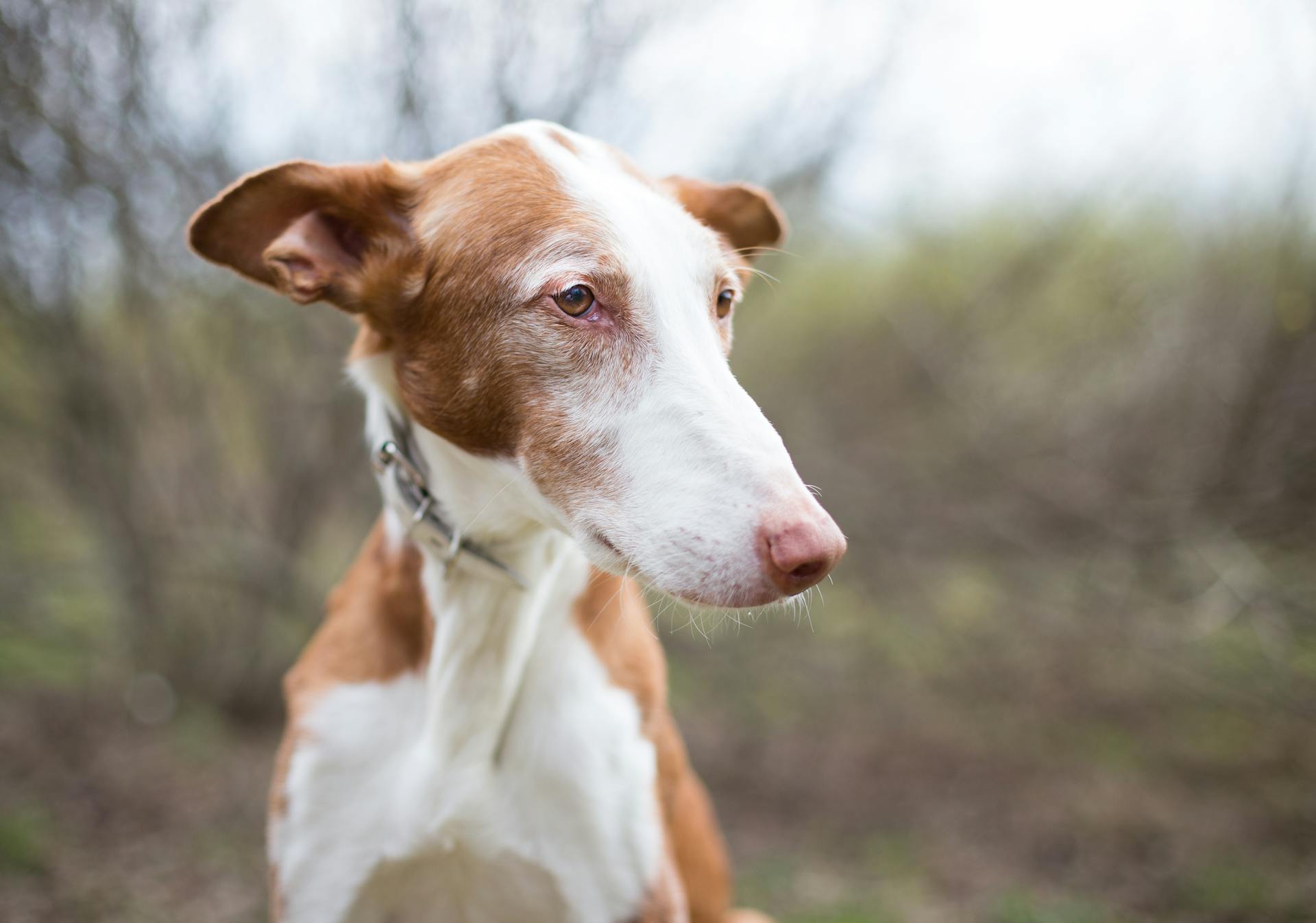
The Atypical Canine Infectious Respiratory Disease Complex, also known as ACIRD, is a common health issue affecting dogs worldwide.
ACIRD is caused by a combination of viral and bacterial pathogens that target the respiratory system, leading to symptoms such as coughing, sneezing, and difficulty breathing.
The disease is highly contagious and can spread quickly among dogs in close proximity, making it a significant concern for dog owners and veterinarians alike.
Symptoms of ACIRD can vary in severity and may include nasal discharge, lethargy, and loss of appetite.
For your interest: Respiratory Allergies in Dogs
Causes and Contributing Factors
The causes and contributing factors of atypical canine infectious respiratory disease complex (CIRDC) are still being researched and debated. A possible bacterium, IOLA KY405, has been tentatively identified as a possible cause by the Veterinary Diagnostic Laboratory at the University of New Hampshire.
Some experts suggest that CIRDC cases may be peaking due to changes in human behavior following the end of COVID-19 lockdowns and disruptions to veterinary care.
Several pathogens have been identified as contributing to CIRDC, including canine parainfluenza virus, canine adenovirus type 2, and canine influenza virus (subtypes H3N2 and H3N8).
These pathogens can cause a range of respiratory symptoms in dogs, from mild coughing to life-threatening pneumonia.
Here are some of the organisms that can contribute to CIRDC:
Diagnosis and Testing
Diagnosing atypical canine infectious respiratory disease complex (ACIRD) can be challenging due to its nonspecific clinical signs.
The diagnosis is often based on a combination of clinical signs, laboratory tests, and epidemiological findings.
A complete blood count (CBC) and serum biochemistry profile may reveal nonspecific changes such as lymphocytosis and mild elevation of liver enzymes.
Radiography and computed tomography (CT) scans may show lung consolidation and interstitial patterns.
A diagnosis of ACIRD is typically made based on a combination of these findings and the exclusion of other potential causes of respiratory disease.
The use of polymerase chain reaction (PCR) testing for specific viral pathogens such as adenovirus and parainfluenza virus may also be helpful in diagnosing ACIRD.
On a similar theme: Dogs with Diabetes Symptoms
Protecting My Dog from CIRDC
Keep your dog's vaccines current to protect against CIRDC. Vaccines not only reduce the chance of your dog becoming ill, but also make your dog less likely to develop severe disease or spread the infection to other dogs.
Dogs can be contagious and still look perfectly healthy, so be aware of this when interacting with other dogs. Keep your dog away from toys and food and water bowls used by dogs outside your household.
Your veterinarian will help you decide which vaccines your dog needs to stay healthy. They'll also advise on the best course of action for your dog's specific situation.
For optimal protection against common respiratory infections, an annual intranasal vaccine against Bordetella, canine adenovirus type 2, and canine parainfluenza is recommended for dogs of certain at-risk groups. Where canine influenza is known to be circulating, an injectable canine influenza vaccine is also recommended.
To further protect your dog, stay informed about places or geographic regions where CIRDC or specific respiratory infections like canine influenza have been reported. Delay or avoid travel with your dog to places where outbreaks are occurring.
Consider reading: Canine Influenza
Investigating and Understanding CIRDC
The investigation into CIRDC has involved collaboration with various experts, including veterinarians and specialists at OSU's Carlson College of Veterinary Medicine and the USDA's National Veterinary Services Laboratory.
Genetic testing by the USDA in December 2023 showed that common causes of canine infectious respiratory disease were present in the cases it investigated.
The University of New Hampshire Veterinary Diagnostic lab reported finding a potential novel bacterial respiratory pathogen in 14% of the samples it tested.
Preliminary data from the University of New Hampshire lab suggests that the novel pathogen may be present in a small number of dog samples, but more research is needed to confirm its role in CIRDC.
The lab's findings are based on analysis of 226 samples, with 31 showing evidence of the potential pathogen.
Further studies are required to prove the causation of CIRDC, according to Robert Gibson, managing director of the New Hampshire Veterinary Diagnostic Laboratory.
Suggestion: New Strain of Kennel Cough 2023
The lab's data supports the possibility of a new pathogen, but it's essential to consider alternative explanations and continue investigating.
Reports of atypical canine infectious respiratory disease began coming in as early as summer 2022, with veterinarians in New Hampshire and other states seeing prolonged coughs and recalcitrant upper respiratory infections.
The Oregon Department of Agriculture received over 200 reports of atypical canine infectious respiratory disease from Oregon veterinarians, with some reports dating back to earlier in the summer of 2023.
For another approach, see: New Kennel Cough
Atypical Cases and Outcomes
In some cases, the Atypical Canine Infectious Respiratory Disease Complex (ACIRDC) can progress to more severe forms, such as viral pneumonia.
The severity of ACIRDC can vary greatly, even among dogs with similar exposures and risk factors.
Dogs that are immunocompromised or have underlying health conditions are at a higher risk of developing severe ACIRDC.
These dogs may require intensive care and treatment, including hospitalization, oxygen therapy, and supportive care.
In some cases, ACIRDC can lead to long-term health consequences, such as chronic respiratory disease or secondary infections.
Check this out: Dog Skin Health
Characteristics
Symptoms of this illness can be quite varied, but they often include a cough, fever, lethargy, sneezing, and watery eyes.
In some cases, the illness can progress to a more severe form, which can be life-threatening.
Most cases are self-limiting and respond well to supportive care.
The duration of the illness can be quite prolonged, lasting six weeks or more.
Antibiotics may be indicated in some cases, although it's essential to rule out other conditions first.
This illness can manifest in three distinct clinical syndromes, including chronic mild/moderate tracheobronchitis, chronic pneumonia, and acute pneumonia.
Atypical Cases
Atypical CIRDC cases have raised concerns in the veterinary community.
These cases differ from the common canine respiratory disease syndrome, which is rarely serious and has known causes.
Roughly nine different bacteria and viruses are known to cause respiratory infections in dogs.
Infection by more than one bacterial or viral agent is common.
Dogs experiencing atypical CIRDC cases often have prolonged coughs, up to several weeks, and may develop secondary pneumonia.
This pneumonia is often unresponsive to antibiotics, making treatment challenging.
Readers also liked: Common Dog Diseases and Symptoms

The lack of a clear cause for these atypical cases has led to speculation about a novel pathogen or variant of a known causative agent.
However, the veterinary community remains skeptical of this possibility.
Laboratories are conducting sequencing to identify the cause of these cases, but so far, testing has not indicated the presence of a novel pathogen or single infectious cause.
Curious to learn more? Check out: Can Allergies Cause Swollen Lymph Nodes in Dogs
Frequently Asked Questions
How long does a respiratory infection last for dogs?
A respiratory infection in dogs typically lasts 5-10 days without complications, but can be longer if dehydration or pneumonia occurs. Recovery time may vary depending on the severity of the infection.
What is going on with dogs in Oregon?
Dogs in Oregon are experiencing a mysterious outbreak of respiratory symptoms, including coughing, sneezing, and pneumonia, prompting concerns among local veterinarians
Sources
- https://www.avma.org/news/questions-remain-canine-respiratory-disease-cases-fall
- https://en.wikipedia.org/wiki/Atypical_canine_infectious_respiratory_disease_complex
- https://www.lsu.edu/vetmed/laddl/acirdc_respiratory_syndrome.php
- https://www.avma.org/resources-tools/pet-owners/petcare/canine-infectious-respiratory-disease-complex-kennel-cough
- https://www.oregonvma.org/news/reports-of-severe-canine-infectious-respiratory-disease-in-oregon
Featured Images: pexels.com


